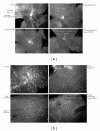Potential Therapeutic Roles for Inhibition of the PI3K/Akt/mTOR Pathway in the Pathophysiology of Diabetic Retinopathy
- PMID: 22132311
- PMCID: PMC3205601
- DOI: 10.1155/2011/589813
Potential Therapeutic Roles for Inhibition of the PI3K/Akt/mTOR Pathway in the Pathophysiology of Diabetic Retinopathy
Abstract
Novel therapeutics such as inhibitors of PI3K/Akt/mTOR pathway presents a unique opportunity for the management of diabetic retinopathy (DR). Second generation mTOR inhibitors have the prospect to be efficacious in managing various stages of disease progression in DR. During early stages, the mTOR inhibitors suppress HIF-1α, VEGF, leakage, and breakdown of the blood-retinal barrier. These mTOR inhibitors impart a pronounced inhibitory effect on inflammation, an early component with diverse ramifications influencing the progression of DR. These inhibitors suppress IKK and NF-κB along with downstream inflammatory cytokines, chemokines, and adhesion molecules. In proliferative DR, mTOR inhibitors suppress several growth factors that play pivotal roles in the induction of pathological angiogenesis. Lead mTOR inhibitors in clinical trials for ocular indications present an attractive treatment option for chronic use in DR with favorable safety profile and sustained ocular pharmacokinetics following single dose. Thereby, reducing dosing frequency and risk associated with chronic drug administration.
Figures


Similar articles
-
Gambogic acid ameliorates diabetes-induced proliferative retinopathy through inhibition of the HIF-1α/VEGF expression via targeting PI3K/AKT pathway.Life Sci. 2018 Jan 1;192:293-303. doi: 10.1016/j.lfs.2017.11.007. Epub 2017 Nov 10. Life Sci. 2018. PMID: 29129773
-
Blocking Mammalian Target of Rapamycin (mTOR) Attenuates HIF-1α Pathways Engaged-Vascular Endothelial Growth Factor (VEGF) in Diabetic Retinopathy.Cell Physiol Biochem. 2016;40(6):1570-1577. doi: 10.1159/000453207. Epub 2016 Dec 21. Cell Physiol Biochem. 2016. PMID: 27997905
-
Repression of microRNA-21 inhibits retinal vascular endothelial cell growth and angiogenesis via PTEN dependent-PI3K/Akt/VEGF signaling pathway in diabetic retinopathy.Exp Eye Res. 2020 Jan;190:107886. doi: 10.1016/j.exer.2019.107886. Epub 2019 Nov 21. Exp Eye Res. 2020. PMID: 31759996
-
Targeting the PI3K/Akt/mTOR pathway in ocular neovascularization.Adv Exp Med Biol. 2014;801:805-11. doi: 10.1007/978-1-4614-3209-8_101. Adv Exp Med Biol. 2014. PMID: 24664774 Review.
-
Inhibitors of the PI3K/Akt/mTOR Pathway in Prostate Cancer Chemoprevention and Intervention.Pharmaceutics. 2021 Aug 3;13(8):1195. doi: 10.3390/pharmaceutics13081195. Pharmaceutics. 2021. PMID: 34452154 Free PMC article. Review.
Cited by
-
Overexpression of angiopoietin 2 promotes the formation of oral squamous cell carcinoma by increasing epithelial-mesenchymal transition-induced angiogenesis.Cancer Gene Ther. 2016 Sep;23(9):295-302. doi: 10.1038/cgt.2016.30. Epub 2016 Aug 5. Cancer Gene Ther. 2016. PMID: 27492854 Free PMC article.
-
Increased intraocular inflammation in retinal vein occlusion is independent of circulating immune mediators and is involved in retinal oedema.Front Neurosci. 2023 Jul 24;17:1186025. doi: 10.3389/fnins.2023.1186025. eCollection 2023. Front Neurosci. 2023. PMID: 37554292 Free PMC article.
-
Apoptotic effect of mtrix metalloproteinases 9 in the development of diabetic retinopathy.Int J Clin Exp Pathol. 2015 Sep 1;8(9):10452-9. eCollection 2015. Int J Clin Exp Pathol. 2015. PMID: 26617754 Free PMC article.
-
Potent dual inhibitors of TORC1 and TORC2 complexes (KU-0063794 and KU-0068650) demonstrate in vitro and ex vivo anti-keloid scar activity.J Invest Dermatol. 2013 May;133(5):1340-50. doi: 10.1038/jid.2012.483. Epub 2013 Jan 10. J Invest Dermatol. 2013. PMID: 23303455 Free PMC article.
-
Current concepts regarding developmental mechanisms in diabetic retinopathy in Taiwan.Biomedicine (Taipei). 2016 Jun;6(2):7. doi: 10.7603/s40681-016-0007-3. Epub 2016 May 5. Biomedicine (Taipei). 2016. PMID: 27154195 Free PMC article.
References
-
- Klein R, Klein BEK, Moss SE. The Wisconsin Epidemiological Study of Diabetic Retinopathy: a review. Diabetes/Metabolism Reviews. 1989;5(7):559–570. - PubMed
-
- Klein R, Klein BEK, Moss SE. The Wisconsin Epidemiologic Study of Diabetic Retinopathy. II. Prevalence and risk of diabetic retinopathy when age at diagnosis is less than 30 years. Archives of Ophthalmology. 1984;102(4):520–526. - PubMed
-
- Saaddine JB, Honeycutt AA, Narayan KMV, Zhang X, Klein R, Boyle JP. Projection of diabetic retinopathy and other major eye diseases among people with diabetes mellitus: United States, 2005–2050. Archives of Ophthalmology. 2008;126(12):1740–1747. - PubMed
-
- Brown JB, Pedula KL, Summers KH. Diabetic retinopathy: contemporary prevalence in a well-controlled population. Diabetes Care. 2003;26(9):2637–2642. - PubMed
-
- Looker HC, Nelson RG, Chew E, et al. Genome-wide linkage analyses to identify loci for diabetic retinopathy. Diabetes. 2007;56(4):1160–1166. - PubMed
LinkOut - more resources
Full Text Sources
Other Literature Sources
Miscellaneous

